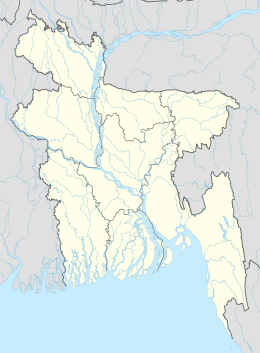Bhasan Char
Native name: ভাসানচর | |
|---|---|
| Geography | |
| Location | Bay of Bengal |
| Coordinates | 22°22′30″N 91°23′33″E / 22.37500°N 91.39250°E |
| Area | 25 sq mi (65 km2) |
| Administration | |
| Division | Chittagong Division |
| District | Noakhali District |
| Upazila | Hatiya Upazila |
| Demographics | |
| Population | 28,000 (May 2022) |
| Additional information | |
| Time zone | |
Bhasan Char (Bengali: ভাসানচর), also known as Char Bhasani (Bengali: চর ভাসানী) , is an island in Hatiya Upazila, Bangladesh.[1] Until 2019[2] it was known as Thengar Char.[1][3] It is located in the Bay of Bengal, about 6 kilometres (3.7 mi) from Sandwip island and 37 miles (60 km) from the mainland.[4]
History[edit]
The island was formed by Himalayan silt in 2006.[1] It spans 40 square kilometres (15 sq mi; 4,000 ha).[5] The Government of Bangladesh planned to construct a total of 1,440 buildings, including 120 cyclone shelters, to relocate 100,000 Rohingya refugees from the mainland camps of Cox's Bazar.[6] The Government of Bangladesh first suggested resettling Rohingya refugees on the island in June 2015.[7] The proposal was characterized by the United Nations Refugee Agency as "logistically challenging".[7] On January 26, 2017, the Bangladeshi government ordered their resettlement nonetheless.[1][3][4] Human Rights Watch called it "a human rights and humanitarian disaster in the making".[1]
In August 2019 the government announced an expansion of the Ashrayan Project (Ashrayan-3) to build 100,000 homes.[8] The houses are built four feet above the ground, in order to protect the refugees from high tidal waves.[9] The public works had amounted to 309.5 million takas by December 2019, a 34% increase from the initial allocation.[2] The additional projects include raising the flood-protection embankment from 9 feet (2.7 m) to 19 feet (5.8 m), and construction of cluster villages, mosques, shelter stations, hospitals, water channelling infrastructure, roads, infrastructure for farming and numerous other land development works under the project.[2][10] The Bangladesh Navy built much of the infrastructure.[10]
In January 2020, the project was moving forward despite opposition from Rohingya leaders and human rights groups. Bangladesh's minister for refugee affairs stated the island is "ready for habitation", though he gave no timetable for the relocation. The government had not permitted foreign journalists or Rohingya leaders to travel to Bhasan Char at the time.[11]
Between December 2020 and January 2021 the first two groups totalling around 4,000 Rohingya had already been sent to the island. On 29 January another 1,778 Rohingya refugees started their journey to the island, with a fourth group to be moved the next day. The process of moving Rohingya refugees will continue until 100,000 have arrived in the island, according to authorities. The Bangladesh government had spent $112 million by this time.[10] A United Nations delegation visited the island for the first time from 17 to 20 March 2021. By this time 13,000 Rohingya lived on the island. The UN Refugee Agency has signed a memorandum in helping the refugees here.[12] The Rohingya may work and contribute to the economy,[10] but may not move off the island.[12] In principle, the island was seen as a temporary solution until the refugees could return home.[10] Some of the first group to move to the island spoke of being coerced. Others spoke of deciding to relocate from the overcrowded camps of Cox's Bazar due to the frequent violence there. The Bangladesh government hoped to assuage UN concerns and that the refugees would get international assistance.[12]
As of May 2022, the Government of Bangladesh has relocated approximately 28,000 Rohingya refugees to Bhasan Char.[13]
The Prime Minister of Bangladesh, Sheikh Hasina, declared that 35,000 Rohingya were transferred to Bhasan Char to "keep Rohingya youth away from criminal activities." She also emphasized the difficulty of repatriating Rohingya back to Myanmar due to the civil war, and preventing foreign armed groups from using Bangladesh as a guerrilla sanctuary.[14]
References[edit]
- ^ a b c d e Kullab, Samya (February 23, 2017). "The Trouble With Thengar Char". Foreign Affairs. Retrieved February 25, 2017.
- ^ a b c "Bhasan Char project cost to rise 34%". The Business Standard. 2019-12-16. Retrieved 2019-12-19.
- ^ a b Rahman, Shaikh Azizur (February 2, 2017). "Plan to move Rohingya to remote island prompts fears of human catastrophe". The Guardian. Retrieved February 25, 2017.
- ^ a b Pokhare, Sugam; Westcott, Ben (January 31, 2017). "Thousands of Rohingya refugees may be sent to remote island". CNN. Retrieved February 25, 2017.
- ^ "UN rapporteur visits Bangladeshi island chosen for Rohingya relocation". efe.com. January 24, 2019. Retrieved March 17, 2019.
- ^ "A remote home for the Rohingya". Reuters. Retrieved Dec 5, 2020.
- ^ a b "UN concern at Bangladesh plan to move thousands of Rohingya to flooded island". The Guardian. June 14, 2015. Retrieved February 25, 2017.
- ^ Khokon, Sahidul Hasan. "Bangladesh: Govt takes up Ashrayan-3 project to shelter Rohingya refugees". India Today. Retrieved 1 August 2019.
- ^ "Inside the Bhashan Char plan for Rohingyas". Dhaka Tribune. January 29, 2019. Retrieved 2019-11-22.
- ^ a b c d e "Bangladesh sends third group of Rohingya refugees to island". Al Jazeera English. 29 January 2021. Retrieved 17 March 2021.
- ^ "Will thousands of Rohingya refugees be sent to a remote island?". Los Angeles Times. January 23, 2020. Retrieved February 5, 2020.
- ^ a b c "UN team visits remote Bangladesh island where Rohingya relocated". Al Jazeera English. 17 March 2021. Retrieved 17 March 2021.
- ^ Refugees, United Nations High Commissioner for. "UNHCR's Grandi urges redoubled support for Rohingya refugees, host communities in Bangladesh". UNHCR. Retrieved 2022-06-30.
- ^ PM Hasina: Myanmar conflict makes Rohingya repatriation difficult. March 4, 2024. Dhaka Tribune Archived March 4, 2024, at the Wayback Machine

